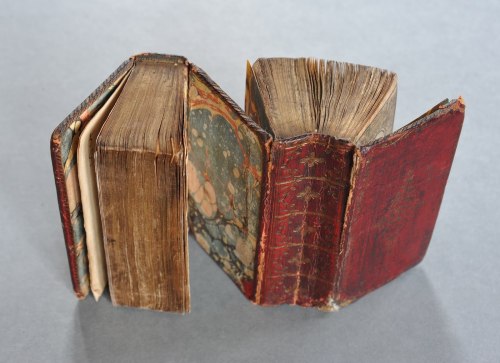Книга, которая открывается со всех сторон!
Прямо из библиотеки Хогвартса…
Книга конца 16 века содержит в себе шесть книг!
Все они аккуратно скрыты внутри одного переплета.
Это молитвенные тексты, напечатанные в Германии в 1550-х годах и 1570-х (в том числе Мартин Лютер)
Каждая из них закрыта своей крошечной застежкой.
Вот тут можно рассмотреть со всех сторон и понять, КАК это сделано:
http://www.flickr.com/photos/25300312@N08/4998209938/
Six books, one binding
Here’s something special. You may remember a blog I posted about dos-à-dos (or “back-to-back”) books. These are very special objects consisting of usually two books, which were bound together at their, well, backs. When you were done with the one book, you would flip the object and read the other. The dos-à-dos book you see here is even more special. Not only is it a rather old one (it was bound in the late 16th century), but it contains not two but six books, all neatly hidden inside a single binding (see this motionless pic to admire it). They are all devotional texts printed in Germany during the 1550s and 1570s (including Martin Luther, Der kleine Catechismus) and each one is closed with its own tiny clasp. While it may have been difficult to keep track of a particular text’s location, a book you can open in six different ways is quite the display of craftsmanship.
Pic: Stockholm, Royal Library. See the full image gallery here.
http://uispeccoll.tumblr.com/post/80465808793/erikkwakkel-six-books-one-binding-heres
А вот тут пост о двойных книгах:
http://erikkwakkel.tumblr.com/post/58806441078/siamese-twins-the-bookbindings-above-are-as-odd


Переплет называется «dos-a-dos»(спина к спине), такой тип переплета делался чаще всего в 16 и 17 веках.
Книги похожи на сиамских близнецов в том, что они представляют два разных блока, соединенных «спинами»: каждая часть имеет одну переплетную доску для себя, а третья доска — общая между ними.
Их содержание показывает, зачем это было сделано: такие книги часто включают взаимодополняющие тексты, например, молитвенник и Псалтирь, или Ветхий и Новый Завет.
Читая один текст, вы можете перевернуть книгу и заглянуть в другую.
The bookbindings above are as odd as they are rare. In fact, I encountered my first only a few days ago while browsing Folger Library’s image database of bookbindings. The binding is called “dos-à-dos” (back to back), a type almost exclusively produced in the 16th and 17th centuries. They are like Siamese twins in that they present two different entities joint at their backs: each part has one board for itself, while a third is shared between the two. Their contents show why this was done: you will often find two complementary devotional works in them, such as a prayerbook and a Psalter, or the Bible’s Old and New Testament. Reading the one text you can flip the “book” to consult the other. The last image above is a unification of no less than seven devotional works printed by the same printer (Feichtinger, Lintz, 1736-1737), showing that the constructions could also encompass much more than just two texts. In the 20th century this type of binding enjoyed a revival with the Double Ace books, which featured two short science fiction stories.
